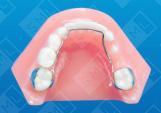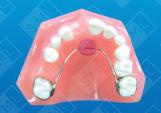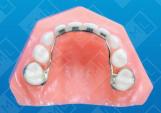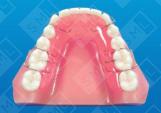
Space Maintenance
Location
When considering the subject of space maintainence for children, it must first be acknowledged that most orthodontic problems begin during the period of time when the development of the entire masticatory apparatus (including dental arch and occlusion) proceeds from primary to permanent dentition. Unfortunately, many patients do not see the orthodontic specialist during this time. Why? Because the orthodontist usually has to depend upon a referral from the general dentist.
Because the general dentist is the one who cares for the dental needs of the vast majority of growing children, it is imperative that they be able to recognize growth problems as they occur. This will allow them to either actively intervene or immediately refer these patients to the orthodontist.
For a smooth transition through the stages of occlusal development the following events must occur:
- The eruption of the first permanent molar will be guided by the distal surface of the second primary molar. The location and arrangement of the permanent incisors will be guided by the mesial surface of the primary canine.
- Once the permanent first molar and incisors are in the arch, (The Mixed Dentition Stage) the canine and two premolars will then erupt into the limited space between the mesial surfaces of the first permanent molar and the distal surface of the lateral incisor. This exchange takes about one and a half years to complete.
- The sum of the mesio-distal widths of the primary cuspid and the first and second primary molars is generally larger than that of the permanent cuspid and premolars -- by about 1mm per quadrant in the maxilla and 2mm per quadrant in the mandible. This difference is called the leeway (or extra) space...and is a fundamental factor in allowing for an easy exchange of these teeth.
- A normal eruption sequence of the succedaneous teeth must take place in both the mandible and maxilla. In the mandible, the most frequent eruption sequence is the cuspid, first bicuspid, and second bicuspid. In the maxilla, the sequence of eruption typically seen is either the first bicuspid, second bicuspid and cuspid or first bicuspid, cuspid and second bicuspid.
- When the second molars begin to erupt, the distal surface of the first permanent molar will guide them into the arch. In most cases, the eruptive force of the second molar will cause a reduction in the dental arch length using up the leeway space. In fact, the arch circumference of the permanent dentition may become shorter than that of the primary dental arch.
Unfortunately, a smooth transition is often disrupted by the premature loss of teeth. Tooth decay, trauma from a fall, or some other accidental injury are just some of the common causes of early tooth loss. When tooth loss occurs, pediatric space management is the key to preventing a serious malocclusion in the permanent dentition. In the posterior quadrants, the early loss of primary teeth often results in a reduction of arch length. This change can directly affect the normal eruption of the adult teeth. If space loss has not already occurred, rapid intervention with a space-maintaining appliance is of utmost importance. In the anterior region, space maintenance is important to maintain normal speech, function, and esthetics.
When it comes to adults, proper space management is important for the adult patient in a variety of situations. During active restorative treatment, there is often a need for an interim appliance to maintain space. For example, an interim space maintainer is often used in young patients who, because of an accident, rampant caries, or hereditary partial anodontia, are missing either anterior or posterior teeth. Other commonly evidenced indications for an interim space maintainer are:
- to maintain space
- to re-establish occlusion
- to replace visible missing teeth while definitive restorative procedures are being accomplished
- to serve while the patient is undergoing periodontal or other prolonged treatment
- when healing is progressing after an extraction or a traumatic injury
- to maintain function while accomplishing minor tooth movement
Select another Appliance Category



























